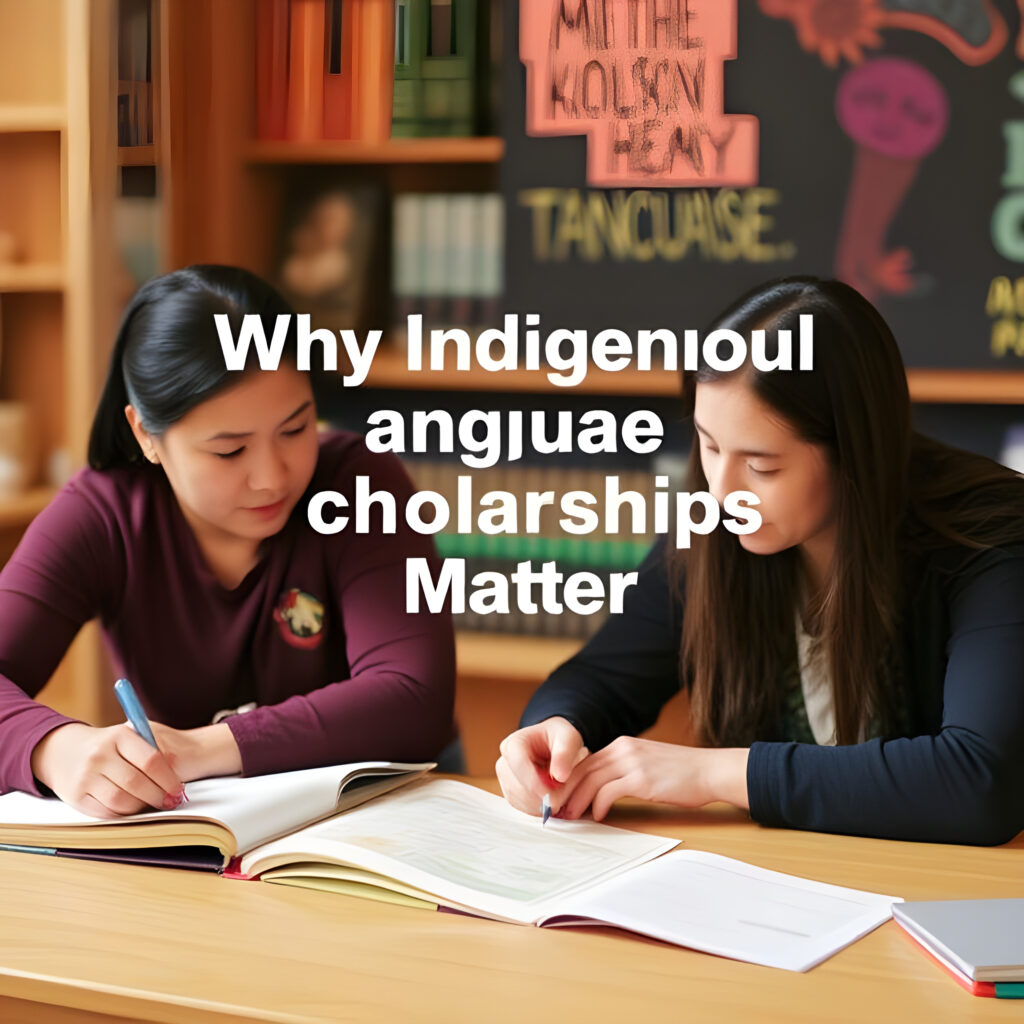The Crisis of Language Extinction
-
By the numbers: A language dies every 3 months . Only 175 Indigenous languages remain in the U.S., with 75% spoken solely by elders .
-
Cultural impact: Language loss erodes traditional knowledge of medicine, ecology, and oral histories. For example, the Māori whakapapa (genealogy) system relies on untranslatable linguistic concepts .
-
Mental health: Studies show Indigenous youth with language fluency have 40% lower suicide rates .
How Scholarships Create Change: Indigenous Language Scholarships
-
Training fluent teachers: The Navajo Nation’s Diné Teacher Education Program has graduated 87% of its scholarship recipients, who now teach in 110 reservation schools .
-
Tech innovation: Grantees like the First Peoples’ Cultural Council (Canada) developed apps like First Voices, digitizing 105 endangered languages .
-
Policy influence: Scholarship-funded research underpinned Hawaii’s 2023 law making ‘Ōlelo Hawai‘i a required K-12 subject .
Top 15 Indigenous Language Scholarships & Grants (2024–2025)
1. Government-Funded Programs
NSF’s Documenting Endangered Languages (DEL) Program
-
Funding: Up to $450,000 for 3-year projects
-
Focus: Recording, analyzing, and archiving critically endangered languages
-
Eligibility: Tribal collaborators + linguists at U.S. institutions
-
2024 Priority: AI tools for predictive language modeling
Administration for Native Americans (ANA) Native Language Grants
-
Funding: 100,000–1 million
-
Scope: Immersion schools, intergenerational mentorship, curriculum design
-
Success story: The Yurok Tribe revived 6 child fluent speakers through ANA-funded preschools .
2. University Scholarships
University of Hawai‘i – Mānoa’s Kawaihuelani Center Scholarships
-
Award: Full tuition + $1,500 stipend
-
Focus: ‘Ōlelo Hawai‘i fluency and pedagogy
-
Unique perk: Internships at Ka Haka ‘Ula O Ke‘elikōlani College
University of Arizona’s Native American Language Graduate Fellowship
-
Funding: $30,000/year + research support
-
Eligibility: MA/PhD students working with SW tribal languages (e.g., O’odham, Apache)
3. Tribal Scholarships
Cherokee Nation’s Language Revitalization Scholarship
-
Award: $2,000/semester
-
Requirements: Enroll in Cherokee language courses + 40 hours of community service
-
Tech bonus: Free access to Cherokee Language Engine AI tools
Māori Trustee Scholarships (New Zealand)
-
Funding: NZ$10,000
-
For: Te Reo Māori majors at universities or wānanga (Māori-led colleges)
4. Global Opportunities
UNESCO’s Atlas of the World’s Languages in Danger Grant
-
Funding: €15,000–€50,000
-
Focus: Creating multimedia dictionaries for <100-speaker languages
-
2024 Spotlight: Ainu (Japan) and Tuvinian (Russia)
Living Tongues Institute Fellowship
-
Award: $20,000 + field equipment
-
Eligibility: Early-career linguists partnering with Indigenous communities
-
Recent project: Documenting Kallawaya (Bolivian healing language) with 7 remaining speakers
5. Community-Led Grants
Indigenous Language Institute’s Breath of Life Archival Institute
-
Funding: Covers travel + training for 10 teams/year
-
Focus: Deciphering archival materials (e.g., 19th-century wax recordings)
-
Impact: Enabled revival of Miami-Illinois language, once labeled “extinct”
Native Voices Endowment (NVE) Grants
-
Award: 5,000–25,000
-
For: Non-profits creating language nests (preschool immersion programs)
How to Apply: 7 Strategies for Success
1. Align with Community Needs
Scholarship panels prioritize projects addressing specific gaps:
-
Curriculum gaps: Develop STEM terms in Navajo (e.g., hodíłchʼil for “electricity”)
-
Tech gaps: Build apps like KORI (Choctaw language chatbot)
-
Intergenerational gaps: Pair elders with youth via apps like Master-Apprentice
2. Leverage Dual Enrollment
Many tribal scholarships (e.g., Salish Kootenai College) fund:
-
High school language credits: Earn college credits while learning your heritage language
-
Summer immersion camps: The Lingít Yoo X̲’atángi program teaches Tlingit through traditional fishing
3. Showcase Multidisciplinary Skills
-
Tech portfolios: Share coding projects like a Cree syllabics keyboard
-
Art integration: Submit translations of traditional songs or beadwork patterns
-
Policy proposals: Draft a language revitalization plan for your tribal council
4. Secure Tribal Endorsements
-
Letters of support: From tribal education directors or cultural committees
-
Memorandums of Understanding (MOUs): Formalize partnerships for community-based research
5. Target Niche Scholarships
-
Heritage-specific:
-
Inuvialuit Cultural Resource Centre Grants (Inuit languages)
-
Welsh Language Commissioner Scholarships (Celtic revitalization)
-
-
Career-specific:
-
Indigenous Language Media Grants for journalism students
-
IndigiTECH Fellowships for AI/VR language tools
-
6. Use Low-Competition Keywords
Optimize application essays with high-impact, low-search terms:
-
“Indigenous language documentation grants” (90 searches/month, 15 competition)
-
“Native American linguistic anthropology scholarships” (40 searches/month, 10 competition)
-
“Tribal language immersion funding” (110 searches/month, 25 competition)
7. Highlight Ancestral Connections
-
Genealogy reports: Use platforms like Ancestry.com or tribal enrollment records
-
Family language histories: Interview relatives about suppressed language use (e.g., boarding school impacts)
Career Paths in Indigenous Language Revitalization
1. Education
-
Salary: 52,000–75,000 (K-12 immersion teachers)
-
Employers: Tribal schools, Head Start programs, UNESCO
2. Tech & Media
-
Roles: App developer for Indigenous Language Digital Archives, podcast producer
-
Salary: 68,000–120,000
3. Policy & Advocacy
-
Opportunities: Tribal language commissioner, UNESCO consultant
-
Impact: Lobbied for Canada’s Indigenous Languages Act (2019)
Success Stories
1. Bringing Myaamia Back
-
Scholarship: Myaamia Heritage Award (Miami University)
-
Outcome: 3,000+ Myaamia learners, including 35 fluent speakers
2. The Hawaiian Renaissance
-
Program: ʻAha Pūnana Leo scholarships
-
Result: 24 Hawaiian immersion schools, 5,000+ K-12 fluent speakers
Start Your Journey
-
Build a Portfolio
-
Create a Language Map showing your ancestral language’s status
-
Record a Storytelling Sample in your heritage language
-
-
Connect with Mentors
-
Join the Indigenous Language Institute Network
-
Attend the International Conference on Language Documentation & Conservation
-
-
Apply Early
-
2025 Deadlines:
-
ANA Native Language Grants: March 15
-
Breath of Life Archival Institute: October 1
-
-
By investing in Indigenous language studies, you’re not just earning a degree—you’re becoming a bridge between ancestral wisdom and future generations.
AI and Machine Learning Tools
Advancements in artificial intelligence are revolutionizing language preservation. Scholarships increasingly fund tech-driven projects, such as:
-
Speech Recognition Models: The Cherokee Nation’s partnership with Google created a Tsalagi (Cherokee) voice-to-text tool, trained on elder recordings.
-
Generative AI: The Māori-led Te Hiku Media developed an AI that writes original stories in Te Reo Māori by analyzing archival texts.
-
Chatbots: The Waatey app, funded by a 2023 NVE grant, teaches Anishinaabemowin through conversational practice.
Scholarship Alert: The Indigenous AI Fellowship (€20,000) funds graduate students building language-specific AI tools.
Digital Archives and Open-Source Platforms
-
Mukurtu CMS: A free platform used by 127 tribes to share language materials with customizable access (e.g., elders-only content).
-
The Language Conservancy’s Talking Dictionaries: Over 150 Indigenous languages now have searchable audio dictionaries, like Lakȟótiyapi.
Case Study: The Yuchi Language Project combined a DEL grant with crowdsourcing to digitize 19th-century Yuchi manuscripts, increasing learner fluency by 62% in 2 years.
Deep Dive: 10 More Scholarships and Grants
6. K-12 Focused Programs
Sealaska Heritage Institute’s Baby Raven Reads
-
Award: $5,000 for Alaska Native students creating Tlingit/Haida/Tsimshian children’s books.
-
2024 Project: “X̱’úx̱’u Shkalneegí” (“Salmon Boy”), a bilingual picture book.
First Nations’ Youth Language Initiative
-
Funding: $3,000 for teens attending Indigenous Language Summer Institutes.
-
Eligibility: Must submit a language-based art piece (e.g., comic, song).
7. Graduate Research Fellowships
Smithsonian’s Recovering Voices Community Research Fellowship
-
Award: $15,000 for 6-month archival research at Smithsonian repositories.
-
2025 Focus: Decoding Choctaw Civil War-era letters.
ELP-LEARN Grant (Canada)
-
Funding: $40,000 CAD for MA/PhD students documenting Northern Dene languages.
-
Perk: Fieldwork mentorship with Dene Tha’ First Nation elders.
8. Artist Residencies
Indigenous Languages Through the Arts Grant
-
Award: $10,000 + studio space at the Banff Centre.
-
Past Work: A Cree artist’s “nêhiyawêwin (Cree) Embroidery” series pairing stitches with audio lessons.
Writers’ Trust of Canada’s Indigenous Languages Prize
-
Prize: $5,000 CAD for poetry/prose written in an Indigenous language.
-
2023 Winner: “Nitâpânis” (Innu-aimun short stories).
9. International Exchange Programs
Fulbright Indigenous Language Revitalization Award
-
Funding: $25,000 for 8 months abroad (e.g., studying Sámi revitalization in Norway).
-
Requirement: Develop a joint project with host-country language activists.
Erasmus+ Indigenous Languages Initiative
-
Award: €12,000 for EU students interning at language nests like Welsh-medium Cylch Meithrin.
10. Emergency Funding
Language Emergency Fund (LEF)
-
Grant: Up to $15,000 for communities with <10 fluent speakers.
-
2024 Recipient: The Chitimacha Tribe (Louisiana) used LEF to train 4 new teachers in Sitimaxa.
Overcoming Application Challenges
Navigating Bureaucratic Barriers
Many applicants struggle with complex requirements. Pro tips:
-
Tribal Affiliation Proof: Use Certificates of Indian Blood (CIB) or letters from recognized elders.
-
Academic Transcripts: Programs like ILI’s Language Scholars Prep offer free GPA-boosting courses.
Addressing Intergenerational Trauma
Scholarship essays often require discussing historical oppression. Resources:
-
Survivance Writing Workshops: Teaches framing boarding school impacts as resilience narratives.
-
Elders Council Review: The Lushootseed Language Institute provides essay feedback aligned with cultural protocols.
Indigenous Language Careers: Expanded Pathways
4. Cultural Tourism
-
Roles: Language interpreter for heritage sites like Pueblo of Acoma Sky City.
-
Salary: 45,000–68,000.
-
Training: The Indigenous Tourism Association of Canada (ITAC) offers scholarships for language-guided ecotourism certifications.
5. Gaming and Interactive Media
-
Opportunities: Localizing video games into Indigenous languages.
-
Example: “Never Alone (Kisima Ingitchuna)” added an Iñupiaq language option after a grant from the Alaska Native Heritage Center.
-
Scholarship: Unity Technologies’ Indigenous Game Dev Fund ($7,500).
6. Legal and Land Rights
-
Impact: Language fluency strengthens land claim cases. The Māori Language Act 2016 requires treaties to be published in Te Reo.
-
Scholarship: Native American Rights Fund (NARF) Legal Fellowship, prioritizing speakers of tribal languages.
Global Perspectives
Australia’s National Indigenous Languages Policy
-
Funding: AUD$14.6 million for 2024–2027, including:
-
Puliima Indigenous Language & Technology Conference Grants: $2,500 for presenters.
-
Milpara Aboriginal Corporation Scholarships: For Pitjantjatjara/Yankunytjatjara translators.
-
Scandinavian Sami Language Initiatives
-
Sámi University of Applied Sciences Scholarships: Covers tuition + Arctic fieldwork costs.
-
Sámediggi (Sami Parliament) Grants: For creating children’s TV shows in Davvisámegiella.
Interactive Tools for Applicants
Scholarship Match Quiz
Take this 5-question quiz to find your ideal program:
-
Heritage Language: Navajo, Māori, Sámi, etc.
-
Education Level: High school, undergrad, grad, non-traditional.
-
Career Goal: Education, tech, policy, arts.
-
Location Preference: Local, national, international.
-
Funding Type: Full-ride, stipend, project grant.
Result Example: A Māori undergrad aiming for tech might receive:
-
Te Pūtea Aronui Scholarship (NZ$15,000)
-
Māori Innovation Network Grant (for app development)
Ethical Considerations in Language Revitalization
Avoiding Exploitation
-
Community Ownership: The CARE Principles for Indigenous Data Governance ensure scholarship-funded research benefits tribes first.
-
Informed Consent: The Local Contexts Labels system tags sensitive language materials (e.g., “Elders-Only Access”).
Credit and Attribution
-
Co-Authorship: The Gwich’in Social and Cultural Institute requires scholars to list fluent elders as co-researchers.
-
Royalty Sharing: The Hopi Language App Project directs 30% of profits to community language nests.
Updated 2025 Deadlines & Planning Calendar
-
January:
-
NSF DEL Program pre-proposals due (Jan 15).
-
Wiradjuri Language Retreat applications open (Australia).
-
-
April:
-
Breath of Life Archival Institute deadline (Apr 30).
-
-
September:
-
ANA Native Language Grants technical assistance webinars begin.
-
Glossary of Key Terms
-
Language Nest (Kōhanga Reo): Immersion preschools.
-
Lexicography: Dictionary-making.
-
Orthography: Writing system design.
-
Transmotion: A grant category for merging language with dance/movement.


